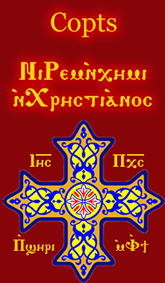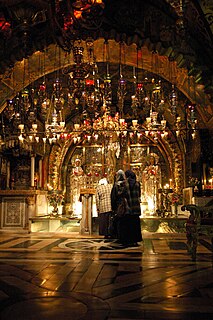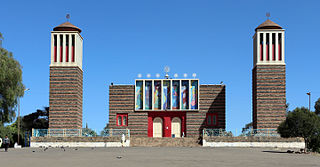
The Coptic Orthodox Church, also known as the Coptic Orthodox Patriarchate of Alexandria, is an Oriental Orthodox Christian church based in Egypt, servicing Africa and the Middle East. The head of the church and the See of Alexandria is the Pope of Alexandria on the Holy Apostolic See of Saint Mark, who also carries the title of Father of fathers, Shepherd of Shepherds, Ecumenical Judge and the thirteenth among the Apostles. The See of Alexandria is titular, and today the Coptic Pope presides from Saint Mark's Coptic Orthodox Cathedral in the Abbassia District in Cairo. The church follows the Coptic Rite for its liturgy, prayer and devotional patrimony. With approximately 25 million members worldwide, it is the country's largest Christian denomination.

The Eastern Orthodox Church, also called the Orthodox Church, is the second-largest Christian church, with approximately 220 million baptised/baptized members. It operates as a communion of autocephalous congregations, each governed by its bishops and adherents in local synods. The church has no central doctrinal or governmental authority analogous to the Head of the Roman Catholic Church, the Pope, but the Ecumenical Patriarch of Constantinople is recognized by them as primus inter pares and regarded as the spiritual leader of many of the eastern Christian parishes. As one of the oldest surviving religious institutions in the world, the Eastern Orthodox Church has played a prominent role in the history and culture of Eastern and Southeastern Europe, the Caucasus, and the Near East. The Eastern Orthodox Church officially calls itself the Orthodox Catholic Church.

Eastern Christianity comprises Christian traditions and church families that originally developed during classical and late antiquity in Western Asia, Northeast Africa, Eastern Europe, Southeastern Europe, Asia Minor, the Malabar coast of South Asia, and parts of the Far East. The term does not describe a single communion or religious denomination.

The Copts are an ethnoreligious group indigenous to North Africa who have primarily inhabited the area of modern Egypt and Sudan since antiquity. Most ethnic Copts are Coptic Orthodox Christians. Coptic Orthodox Christians are the largest Christian denomination in Egypt and in the Middle East. Coptic Orthodox Christians are also the largest Christian denomination in Sudan and Libya. Historically, ethnic Copts spoke the Coptic language, a direct descendant of the Demotic Egyptian that was spoken in late antiquity.

Severus the Great of Antioch, also known as Severus of Gaza, was the Patriarch of Antioch, and head of the Syriac Orthodox Church, from 512 until his death in 538. He is venerated as a saint in the Oriental Orthodox Church, and his feast day is 8 February.

The Coptic Orthodox pope, also known as the Bishop of Alexandria, is the leader of the Coptic Orthodox Church, with ancient Christian roots in Egypt. The current holder of this position is Pope Tawadros II, who was selected as the 118th pope on November 18, 2012.

Religion in Egypt controls many aspects of social life and is endorsed by law. The state religion of Egypt is Islam. Although estimates vary greatly in the absence of official statistics. Since the 2006 census religion has been excluded, and thus available statistics are estimates made by religious and non-governmental agencies. The country is majority Sunni Muslim, with the next largest religious group being Coptic Orthodox Christians. The exact numbers are subject to controversy, with Christians alleging that they have been systemically under-counted in existing censuses.

The Patriarchate of Alexandria and all Africa, also known as the Greek Orthodox Church of Alexandria, is an autocephalous patriarchate that is part of the Eastern Orthodox Church. Its seat is in Alexandria and it has canonical responsibility for the entire African continent.

Christianity is the second largest religion in Egypt. The history of Egyptian Christianity dates to the Roman era as Alexandria was an early center of Christianity.

Christianity has been, historically a Middle Eastern religion with its origin in Judaism. Eastern Christianity refers collectively to the Christian traditions and churches which developed in the Middle East, Egypt, Asia Minor, the Far East, Balkans, Eastern Europe, Northeastern Africa and southern India over several centuries of religious antiquity. It is contrasted with Western Christianity which developed in Western Europe. As a historical definition the term relates to the earliest Christian communities and their long standing traditions that still exist.

Coptic history is the part of the history of Egypt that begins with the introduction of Christianity in Egypt in the 1st century AD during the Roman period, and covers the history of the Copts to the present day. Many of the historic items related to Coptic Christianity are on display in many museums around the world and a large number is in the Coptic Museum in Coptic Cairo.

Christianity, which originated in the Middle East in the 1st century AD, is a significant minority religion within the region. Christianity in the Middle East and North Africa is characterized by the diversity of its beliefs and traditions, compared to Christianity in other parts of the Old World. Christians now make up approximately 5% of the total Middle Eastern population, down from 20% in the early 20th century. Cyprus is the only Christian majority country in the Middle East, with Christians forming between 76% and 78% of the country's total population, and most of them adhere to Eastern Orthodox Christianity. Lebanon has the second highest proportion of Christians in the Middle East, ranging between 39% and 41% and predominantly consisting of Maronite Christians. Egypt has the next largest proportion of Christians, at around 10% of its total population. Copts, numbering around 10 million, constitute the single largest Christian community in the Middle East.
Oriental Orthodoxy is the communion of Eastern Christian Churches that recognize only three ecumenical councils — the First Council of Nicaea, the First Council of Constantinople and the Council of Ephesus. They reject the dogmatic definitions of the Council of Chalcedon. Hence, these Churches are also called Old Oriental Churches or Non-Chalcedonian Churches.

The Oriental Orthodox Churches are a group of Eastern Christian churches adhering to Miaphysite Christology, with a total of approximately 60 million members worldwide. The Oriental Orthodox Churches are broadly part of the trinitarian Nicene Christian tradition shared by today’s mainstream churches, and represent one of its oldest branches.

In the 5th century in Christianity, there were many developments which led to further fracturing of the State church of the Roman Empire. Emperor Theodosius II called two synods in Ephesus, one in 431 and one in 449, that addressed the teachings of Patriarch of Constantinople Nestorius and similar teachings. Nestorius had taught that Christ's divine and human nature were distinct persons, and hence Mary was the mother of Christ but not the mother of God. The Council rejected Nestorius' view causing many churches, centered on the School of Edessa, to a Nestorian break with the imperial church. Persecuted within the Roman Empire, many Nestorians fled to Persia and joined the Sassanid Church thereby making it a center of Nestorianism. By the end of the 5th century, the global Christian population was estimated at 10-11 million. In 451 the Council of Chalcedon was held to clarify the issue further. The council ultimately stated that Christ's divine and human nature were separate but both part of a single entity, a viewpoint rejected by many churches who called themselves miaphysites. The resulting schism created a communion of churches, including the Armenian, Syrian, and Egyptian churches, that is today known as Oriental Orthodoxy. In spite of these schisms, however, the imperial church still came to represent the majority of Christians within the Roman Empire.

The state church of the Roman Empire refers to the church approved by the Roman emperors after Theodosius I issued the Edict of Thessalonica in 380, which recognized the catholic orthodoxy of Nicene Christians in the Great Church as the Roman Empire's state religion. Most historians refer to the Nicene church associated with emperors in a variety of ways: as the catholic church, the orthodox church, the imperial church, the imperial Roman church, or the Byzantine church although some of those terms are also used for wider communions extending outside the Roman Empire. The Eastern Orthodox Church, Oriental Orthodoxy, and the Catholic Church all claim to stand in continuity from the Nicene church to which Theodosius granted recognition, but do not consider it to be a creation of the Roman Empire.

The Eritrean Orthodox Tewahedo Church is an Oriental Orthodox church with its headquarters in Asmara, Eritrea. Its autocephaly was recognised by Shenouda III, Pope of the Coptic Orthodox Church of Alexandria after Eritrea gained its independence from Ethiopia in 1993.
Copts in Libya may refer to people born in or residing in Libya of full or partial Coptic origin. Coptic people are an ethnoreligious group that form the largest Christian group in Libya, the Coptic Orthodox Church in the country having an estimated 60,000 adherents. The Coptic Church is known to have historical roots in Libya long before the Arabs advanced westward from Egypt into Libya. A part of the community is made up of immigrants from Egypt.

In certain denominations of Christianity, hygiene in Christianity includes a number of regulations involving cleanliness before prayer, as well as those concerning diet and apparel.
















